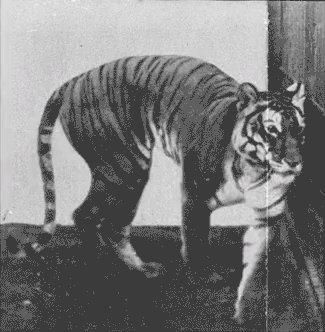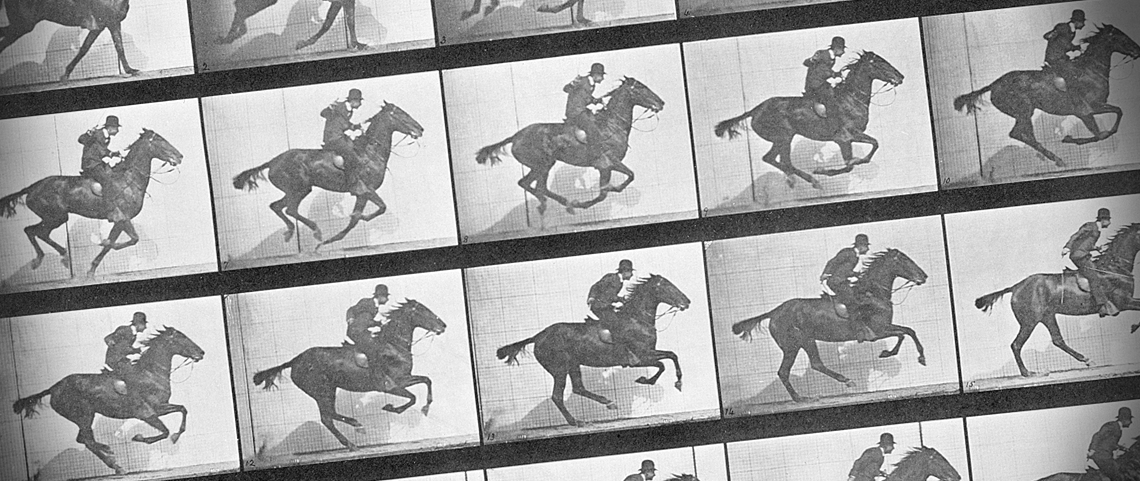
Muybridge In Motion
Eadweard Muybridge (9th April 1830 – 8th May 1904) was a pioneering photographer and inventor. Known worldwide for his contributions to art (with several technological patents to his name) his work was a forerunner to motion picture making in the days before flexible film strips. His most famous works are his photographs of horses in motion, the first of which proved to stunned press that at one specific point in their movement that all four limbs are off the ground. People were astonished – nobody had ever captured such precise documentation of the animal’s movement before.
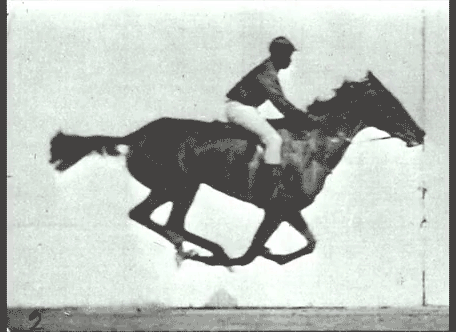
Animation of Eadweard Muybridge’s Jockey riding a race horse from his ‘Animal Locomotion’ series, 1878/87 / J. Paul Getty Museum, Los Angeles, USA / Bridgeman Images
Primarily utilising a novel dry-plate approach with a series of large cameras containing glass plates in a line, timed with a variety of devices all inside a wooden frame, Muybridge created still-by-still motion studies of animals and people in motion – for example in walking, posing and running positions – and these were added to discs and viewed in a zoopraxiscope to give the illusion of movement.
Below, we present a selection of additional stills animated by our team in-house – enabling these performers, actors and animals to be viewed as they would’ve appeared over 120 years ago before the cameras.
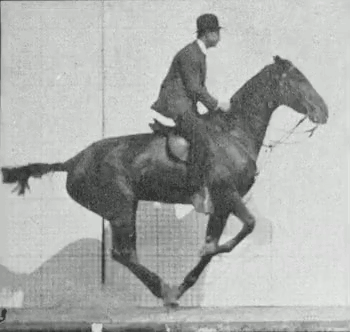
Animation of ‘Man and horse jumping a fence’, plate 640 from ‘Animal Locomotion’, 1887, by Eadweard Muybridge / The Stapleton Collection / Bridgeman Images
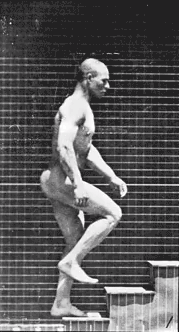
Animation of ‘Man ascending stairs’, from ‘Animal Locomotion’, 1887 Eadweard Muybridge / Bridgeman Images
Before his photography career really took off, Muybridge worked as a bookseller, and in 1852 established himself in San Francisco. His shop was a success and by 1860 he was planning a business trip to Europe. He missed his boat and was forced to use a stagecoach to travel the first leg of his journey, which crashed after speeding down a mountainside.
Muybridge was ejected from the vehicle and sustained a head injury which kept him in hospital for three months – supposedly his frontal cortex was damaged, though scientific examination of his injuries was obviously very limited at the time.
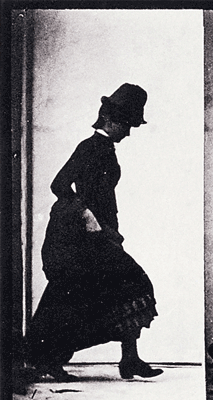
Animation of Motion Study, c.1872-1885 (collotype plate), Eadweard Muybridge (1830-1904) / Private Collection / Photo © Christie’s Images / Bridgeman Images
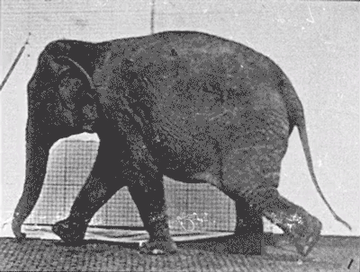
Animation of ‘Elephant walking’, plate 733 from ‘Animal Locomotion’, 1887, by Eadweard Muybridge / Bridgeman Images
Muybridge historians theorise that it may be his damaged frontal lobe that led to his experimentation with photography, lack of interest regarding his usage of nude or clothed models, and insisting on frequent modifications of how his name was spelt. His temperament was also wildly variable. He claimed to see double frequently.
His perception of the world around him had completely changed – and so too had his method of artistic expression. He observed animals and humans in slow, distorted motion, inspiring him to capture their movements as individual images.
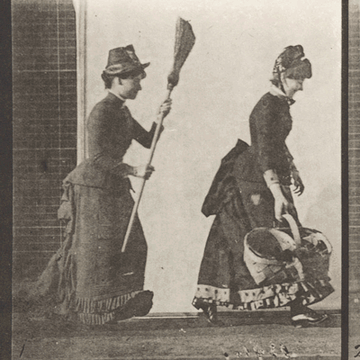
Animation of Two Models, 16 chasing 4 with a broom, 1885 (collotype on paper), Eadweard Muybridge (1830-1904) / Addison Gallery of American Art, Phillips Academy, Andover, MA, USA / gift of the Edwin J. Beinecke Trust / Bridgeman Images
Muybridge recorded standard human and animal movement, in the former case sometimes while performing specific tasks. He utilised both male and female models, both clothed and unclothed, seemingly unconcerned with his period’s customs regarding nudity, highly controversial in the period in which he worked.
In 1874, Muybridge married a 21-year old divorcee, Flora Shall-cross Stone. She and Muybridge had a son, Florano, but Muybridge doubted his paternity when he discovered his wife had been receiving letters from another man – drama critic Major Henry Larkyns. Incriminatingly, the letters noted that Larkyns had previously ‘given her child’. A man of impulse, Muybridge promptly visited Larkyns. As he approached, he announced ”Good evening, Major, my name is Muybridge and here’s the answer to the letter you sent my wife” before shooting him dead at point blank. Shortly after, he was put on trial.
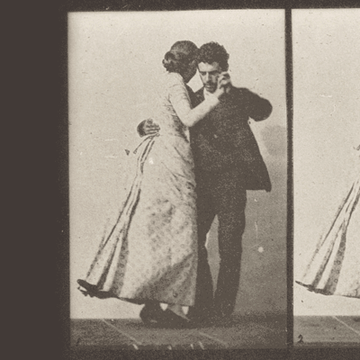
Animation of Dancing Waltz, Two Models, 1885 (collotype on paper), Eadweard Muybridge (1830-1904) / Addison Gallery of American Art, Phillips Academy, Andover, MA, USA / gift of the Edwin J. Beinecke Trust / Bridgeman Images
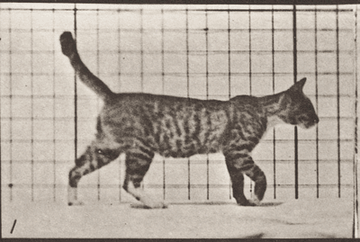
Animation of Cat; Walking, Change to Galloping, 1885 (collotype on paper), Eadweard Muybridge / Addison Gallery of American Art, Phillips Academy, Andover, MA, USA / gift of the Edwin J. Beinecke Trust / Bridgeman Images
At the trial, Muybridge pleaded not guilty due to insanity caused by his aforementioned head injury. Colleagues gave evidence in support, claiming his personality had indeed changed from genial to erratic. His behaviour in court seemed to support this and he was found not guilty on the grounds of ‘justifiable homicide’. His career remained largely unaffected.
Sponsored by the University of Pennsylvania he continued to make motion studies, which were compiled into a successful book. He returned to England in 1894 and died in 1904, in Kingston-upon Thames. In spite of a career with its fair share of ups and downs, the historic significance of his work and its technical genius is still recognised today.
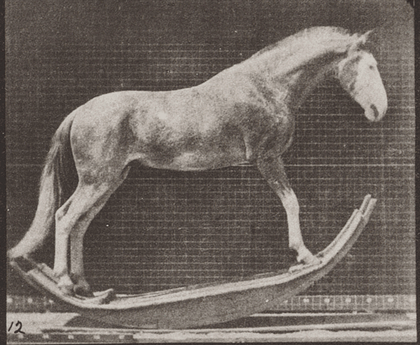
Animation of Hornet the horse, Rocking; 1885 (collotype on paper), Eadweard Muybridge (1830-1904) / Addison Gallery of American Art, Phillips Academy, Andover, MA, USA / gift of the Edwin J. Beinecke Trust
From the experimental and humorous to the creepy and bizarre, explore our whole archive of Muybridge related content – some plates digitally restored
See all our Muybridge animated clips currently available – more are being added.
Read More
Not satisfied your apetite for film?
Discover Artists at work on film

